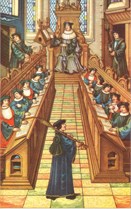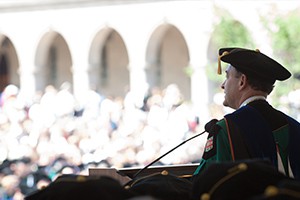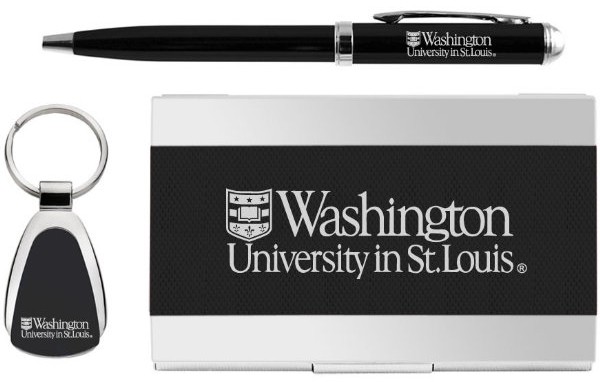The Commencement Ceremony
Washington University in St. Louis and other American universities, public and private, follow the pattern of degree granting developed at the University of Paris, founded about 1100.
In the early days of the University of Paris,
 the discipline and education of the students fell under the jurisdiction of the Bishop of Paris, who claimed supervision of curriculum and degree-granting. However, the Bishop faced opposition from the teaching masters, who felt that they were the proper judges of the students’ qualifications. The masters demanded the right to grant the degree. By 1200, the Bishop and the teaching masters had reached a compromise: the masters judged the merits of the students and then recommended them to the Bishop, who conferred the degree.
the discipline and education of the students fell under the jurisdiction of the Bishop of Paris, who claimed supervision of curriculum and degree-granting. However, the Bishop faced opposition from the teaching masters, who felt that they were the proper judges of the students’ qualifications. The masters demanded the right to grant the degree. By 1200, the Bishop and the teaching masters had reached a compromise: the masters judged the merits of the students and then recommended them to the Bishop, who conferred the degree.
The contemporary Commencement ceremony
 is the successor to this medieval compromise. The faculty sits on the platform in its role as teacher and examiner. Its leaders, the deans, present the qualified candidates to the chancellor. Acting upon the recommendation of the faculty, the chancellor, as executive officer of the Board of Trustees, formally confers the appropriate degree.
is the successor to this medieval compromise. The faculty sits on the platform in its role as teacher and examiner. Its leaders, the deans, present the qualified candidates to the chancellor. Acting upon the recommendation of the faculty, the chancellor, as executive officer of the Board of Trustees, formally confers the appropriate degree.
A Celebrated Tradition

Trace the history of Commencement at Washington University in St. Louis from the first ceremony in 1862.
Washington University in St. Louis was founded in 1853 under the name Eliot Seminary. It was located in downtown St. Louis for its first 50 years until, in 1894, the university purchased ground for a new site on the edge of the city. Frederick Law Olmsted developed the site plan, and the architecture firm of Cope and Stewardson designed buildings.
In 1900, construction began on the first five buildings of a plan based on the medieval courtyards of Oxford and Cambridge Colleges. The first Gothic buildings – Brookings Hall, Ridgley Hall, Cupples Hall I and Busch Hall – form the Brookings Quadrangle, the site of the university Commencement ceremony each spring.
Washington University’s first Commencement ceremony was held in Collegiate Hall, which was the main building of the downtown campus (the building and downtown campus no longer exist).
The first five graduates were: Henry Anderson, twins Charles and Henry Branch, Thomas Lamb Eliot (son of university cofounder William Greenleaf Eliot), and Regis Chauvenet (son of William Chauvenet, chair of mathematics and astronomy and later chancellor from 1862 to 1869). During the ceremony, each graduate gave an oration. Charles Branch’s was in Latin.
Phoebe Couzins was the first woman graduate of the law school, the first woman law graduate in Missouri and the third woman to graduate from any law school in the United States. She went on to become the first woman U.S. marshal as well as a leader in the women’s suffrage movement.
Walter Moran Farmer, a law student, became the first African American to earn a degree from Washington University. He became the first African-American lawyer to argue before the Missouri Supreme Court.
Anna Isabel Mulford, a graduate student in the botany program, was the first student to earn a doctoral degree from the university. Her dissertation examined agaves in the United States and, as part of her research, she discovered several species that were subsequently named for her, including “Mulford’s milkvetch” (astragalus mulfordiae), which she discovered in 1892 near Boise, Idaho.
The first Commencement ceremony was held on the Hilltop Campus (now the Danforth Campus) in 1905. The formal dedication of the Hilltop Campus took place at the ceremony.
The Washington University School of Nursing’s first class, numbering five, was graduated in 1908. All nursing programs were terminated in July 1969. Over its 64-year history, the School of Nursing graduated more than 2,000 nurses.
Commencement was held in the Field House.
Charles Lindbergh was slated to receive an honorary degree in 1928, but he canceled at the last minute and was awarded the degree in absentia. He was to pick up the degree later but never did so. In 1996, the degree was uncovered in the School of Law when the faculty and staff were moving from Mudd Hall to Anheuser-Busch Hall.
The Lamp of Learning was passed on during a ceremony at the Alumni-Senior dinner.
General George Marshall, author of the Marshall Plan, delivered the Commencement address.
The Commencement ceremony moved to a temporary stage built in front of Ridgley Hall in Brookings Quadrangle.
Beaumont Pavilion in Brookings Quadrangle became the ceremony’s permanent home.
Ella Fitzgerald received an honorary degree.
Civil rights leader Julian Bond spoke at Commencement.
 the discipline and education of the students fell under the jurisdiction of the Bishop of Paris, who claimed supervision of curriculum and degree-granting. However, the Bishop faced opposition from the teaching masters, who felt that they were the proper judges of the students’ qualifications. The masters demanded the right to grant the degree. By 1200, the Bishop and the teaching masters had reached a compromise: the masters judged the merits of the students and then recommended them to the Bishop, who conferred the degree.
the discipline and education of the students fell under the jurisdiction of the Bishop of Paris, who claimed supervision of curriculum and degree-granting. However, the Bishop faced opposition from the teaching masters, who felt that they were the proper judges of the students’ qualifications. The masters demanded the right to grant the degree. By 1200, the Bishop and the teaching masters had reached a compromise: the masters judged the merits of the students and then recommended them to the Bishop, who conferred the degree. is the successor to this medieval compromise. The faculty sits on the platform in its role as teacher and examiner. Its leaders, the deans, present the qualified candidates to the chancellor. Acting upon the recommendation of the faculty, the chancellor, as executive officer of the Board of Trustees, formally confers the appropriate degree.
is the successor to this medieval compromise. The faculty sits on the platform in its role as teacher and examiner. Its leaders, the deans, present the qualified candidates to the chancellor. Acting upon the recommendation of the faculty, the chancellor, as executive officer of the Board of Trustees, formally confers the appropriate degree.
